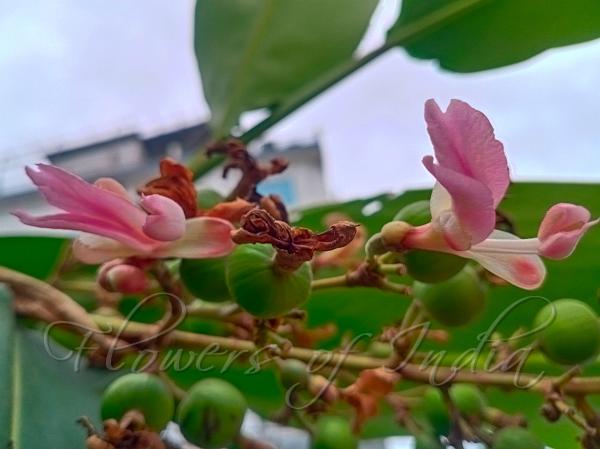|
| Black Galangal |
|

|

| File size | 552596 |
| Original date | 7/10/23 4:36 PM |
| Resolution | 4608 x 3456 |
| Flash | Flash did not fire |
| Focal length | 4.05mm |
| Exposure time | 1/123s |
| Aperture | 1.78 |
| Focus Distance | |
| Metering Mode | Center weighted average |
| Camera make | vivo |
| Camera model | vivo 1915 |
| Sensor type |
|
|
|
|
Photo: |
Botanical name: Alpinia nigra Family: Zingiberaceae (Ginger family)
Synonyms: Alpinia allughas, Amomum nigrum
Synonyms: Alpinia allughas, Amomum nigrum
Black Galangal is a herbaceous plant, grows well on
riverside and can also grow on moist land. The underground stem is
rhizome and aerial stem is pseudo-stem which consists of leaf sheath.
Leafy stems are loosely clumped, 1.5-2 m high. Rhizome is horizontal,
up to 2 cm thick, dull cream inside. Leaves are 30-50 x 10 cm,
oblong-lanceshaped, tapering, sparsely hairy below. Panicle less
branched, up to 15 cm long, slightly oblique to the stem, densely
woolly; bracts spathaceous. Flowers are usually solitary in a bract;
bracteoles tubular; calyx 1 cm long, hairy, split on one side; flowers
yellowish, lobes 1.5 cm long, oblong, velvet-hairy outside; lip 2.5 cm,
obscurely 3-lobed; ovary densely velvet-hairy. The fruit is a berry
having many seeds, and the pericarp is thin and green when it is young,
becoming black and brittle when it gets old. The shoot of the plant
along with a part of rhizome is used by the indigenous tribal people of
Tripura as vegetable. Black Galangal is found in Eastern Himalayas,
Bhutan and NE India, at altitudes of 900-1100 m. It is also found in
parts of SE Asia and Sri Lanka. Flowering: July-August.
Medicinal uses: The rhizome is used as an
aphrodisiac, tonic, diuretic, expectorant, appetizer and analgesic. It
is also used in the treatment of impotence and bronchitis. In most
tribal communities the root pounded and mixed with rice whisky is
applied to skin for fungal infections, such as ringworm and melasma.
The boiled green root is a potent carminative to reduce flatulence or
dyspepsia. A root extract is taken thrice daily for the treatment of
gastric ulcers, and taken twice daily for the treatment of jaundice by
the Chakmas. Its use as an antiinflammatory and analgesic agent has
been supported by experiments in mice.
The rhizome is used as an
aphrodisiac, tonic, diuretic, expectorant, appetizer and analgesic. It
is also used in the treatment of impotence and bronchitis. In most
tribal communities the root pounded and mixed with rice whisky is
applied to skin for fungal infections, such as ringworm and melasma.
The boiled green root is a potent carminative to reduce flatulence or
dyspepsia. A root extract is taken thrice daily for the treatment of
gastric ulcers, and taken twice daily for the treatment of jaundice by
the Chakmas. Its use as an antiinflammatory and analgesic agent has
been supported by experiments in mice.
Medicinal uses:
 The rhizome is used as an
aphrodisiac, tonic, diuretic, expectorant, appetizer and analgesic. It
is also used in the treatment of impotence and bronchitis. In most
tribal communities the root pounded and mixed with rice whisky is
applied to skin for fungal infections, such as ringworm and melasma.
The boiled green root is a potent carminative to reduce flatulence or
dyspepsia. A root extract is taken thrice daily for the treatment of
gastric ulcers, and taken twice daily for the treatment of jaundice by
the Chakmas. Its use as an antiinflammatory and analgesic agent has
been supported by experiments in mice.
The rhizome is used as an
aphrodisiac, tonic, diuretic, expectorant, appetizer and analgesic. It
is also used in the treatment of impotence and bronchitis. In most
tribal communities the root pounded and mixed with rice whisky is
applied to skin for fungal infections, such as ringworm and melasma.
The boiled green root is a potent carminative to reduce flatulence or
dyspepsia. A root extract is taken thrice daily for the treatment of
gastric ulcers, and taken twice daily for the treatment of jaundice by
the Chakmas. Its use as an antiinflammatory and analgesic agent has
been supported by experiments in mice. | Identification credit: Nidhan Singh, M. Sabu | Photographed in Manipur & Assam. |
• Is this flower misidentified? If yes,